By Kathleen Sloan
We are hardwired to understand the world through stories and left to my own devises I seek out artists relating their hero’s journey, usually through the human figure. Wendy Tremayne’s paintings have these elements.
Her work is on display at Rio Bravo Fine Art at 110 N. Broadway St. and Artist Abbey at 103 E. 1st Ave. in Truth or Consequences.
Joseph Campbell, who wrote “A Hero with a Thousand Faces,” believed a hero is one who is resolute in finding their own path. The hero’s path, by definition, he said, will be unclear, because it unfolds step by step and requires the bravery to leap continually into the unknown. A clear path indicates you are following someone else’s. It’s essential to civilization that we find our own path, he said.
“We’re not on our journey to save the world but to save ourselves,” Campbell said. “But in doing that, you save the world. The influence of a vital person vitalizes.”
A conceptual artist for more than twenty years, organizing what some might call “happenings,” Tremayne purposely delayed working in oil paints until she turned 50.
A writer as well, it makes sense that Tremayne’s paintings are figurative and narrative. A former teacher described her paintings as similar “to Nirvana [the band] lyrics. You don’t quite know what is going on, but somehow you get it.”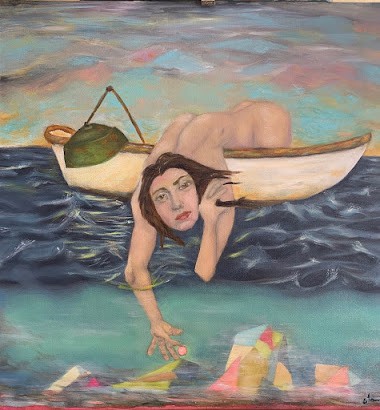
“I want the viewer to know they are being told a story,” Tremayne said. “It doesn’t matter what they think the story is. That ‘somehow you get it,’ that’s what I’m shooting for.”
Sometimes she sees the whole canvas in her head, sometimes in numinous pieces she gathers like a magpie. Only in the process of painting—which upends her preconceived notions—does the meaning become clear.
“Bits gather. I’ll take a screen shot of the color chartreuse, I get a feeling about how the wind carries things, I see a figure bent over that has gravity for me. When an image haunts me, when it won’t go away, I know it’s important. As I paint it, the story will tell me what it is.”
In the untitled work of a woman in a boat, Tremayne started the painting thinking she was “hammering nails into her flesh, but as I painted I realized she is pulling the nails out [of her flesh].”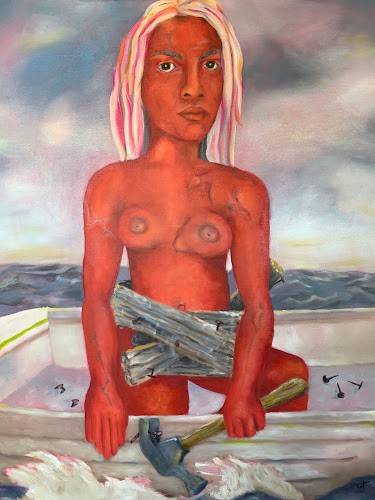
Campbell said a hero will know when they are on the right path because “invisible hands will come to your aid.” The invisible guides invariably show up while Tremayne paints, affirming she is on the right path, telling her and she telling us through her painting that self-harming can be alchemized into self-healing.
Tremayne’s practice of Sufism informs her work. About 20 years ago she studied it for four years and then became a teacher. There are many orders of Sufism, hers focusing on nature as the ultimate source of wisdom.
“Nature is the truest book or doctrine,” Tremayne said. “If you tune into nature it will receive you and tell you what you need. All the practices are to dissolve the veil that makes us feel separate from nature. The law of thermodynamics, gravity, breath work, are all part of nature. In our practice, we extend our consciousness out into the universe, focusing on a nearby flower or on the rings of Saturn.”
Tremayne’s Sufi practice of dissolving the veil has her zooming into vast inner and outer spaces. One of her paintings is about the “Seven Sisters,” the Pleiades constellation, a place, she said, “I feel very comfortable” and with which “I have a deep connection.” This dissolution and emersion comes across in Tremayne’s completely unique approach to space in her paintings. The same painting may combine perspective, shallow space and modern abstract forms—a combination that has a psychological and visual rightness.
She admires the surrealist Remedios Varo’s paintings, “who is informed by another world. The boundary is soft,” Tremayne said. But Varo’s paintings depict a consistent, room-like space. Ilya Zomb is another artist she admires—for fantasy narratives that draw on the real, an unlimited palette, and the balance between painting figures, animals and other objects “loosely and hyper-focused.” He too presents the viewer with a consistent three-dimensional perspectival space. Both Varo and Zomb impose a resolved world on the viewer. Tremayne’s whole but multi-spatial world makes the viewer reach harder to understand the world presented. 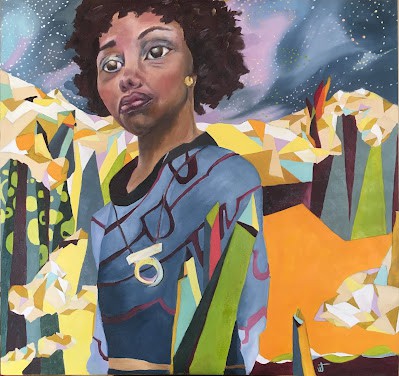
Tremayne’s brush work is also looser than Varo’s or Zomb’s, dropping out medium tones, the contrast between high and low tones denoting action that tweaks the viewer’s empathetic body response. Tremayne’s world is not still, as are other surreal or fantasy paintings.
But above all, what arrests the viewer are Tremayne’s faces, the protagonist-hero that convinces you to journey with her.
“If there is not a face, I just don’t care,” Tremayne said. “I paint the face last and my heart races through the whole thing, not because I’m nervous, but because I’m amped. There is something about capturing a real human expression. The face is the part I know is going to go great.”
Untrained in oil painting, Tremayne, for the last few years has “enjoyed the naiveté, the blindness, which has been good to me. I’m aware I will no longer be able to rely on that. I need to scale up, although I do have a fear of getting too trained.”
Tremayne recently took a class with Shana Levenson in Albuquerque, who photographed each student and had them copy subdivided one-inch photographic squares onto the canvas. “I never want to paint like that, but I want to get better at details to say what I mean better. I’d like to know what you think of it.”
I think intelligence, curiosity and humor beam out of the face, while also expressing a feeling of constraint—like someone on another’s path. 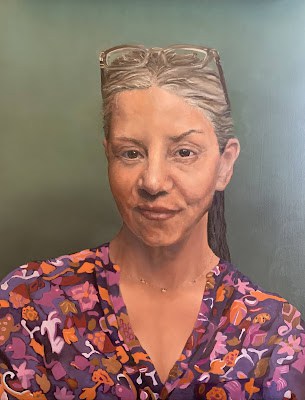
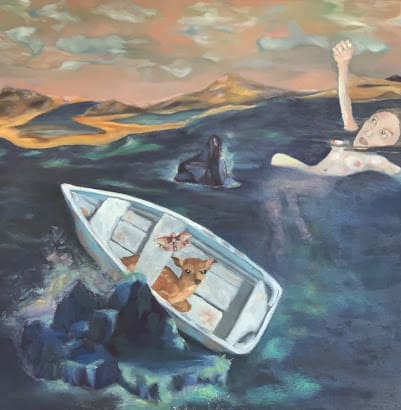
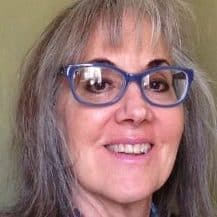
Thanks, Kathleen for the nice write up on Wendy. I’m very proud of Wendy’s accomplishments. She has made great strides since she first sought my help in getting started on this journey. I think I’m safe to say she is now standing on a firm foundation in her craft, one that doesn’t need me anymore. Yet, I am always here if she needs me.